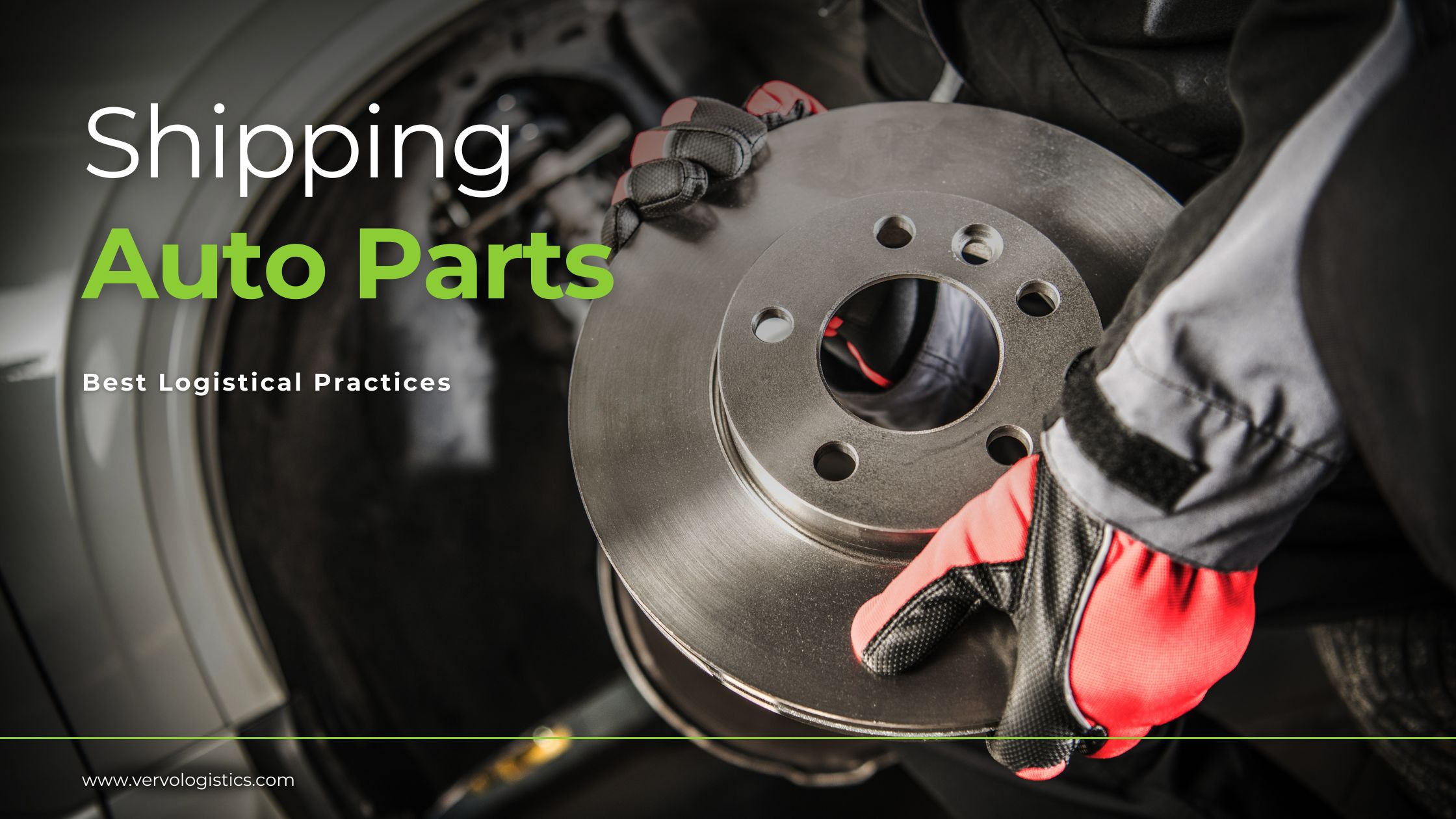The logistics of shipping auto parts requires specialized expertise in packaging, handling, and cargo securing. Auto parts range from heavy engines to fragile sensors. This article explores the technical best practices of auto part logistics in detail. We review proven methods for safely transporting key components, including the following:
1️⃣ Battery
2️⃣ Spark Plugs
3️⃣ Alternators
4️⃣ Air Filters
6️⃣ Tires
7️⃣ Brakes
Auto Batteries
One of the most in-demand spare parts is the battery. To safely ship auto batteries, we follow certain logistical practices. First, batteries should be placed in sturdy boxes or crates with dividers, braces, or cushioning to prevent movement and damage. We seal boxes with tape and mark them as "Battery" and "This Side Up."
Batteries are classified as dangerous goods, so all hazmat shipping regulations must be followed. This includes proper labeling, shipping papers, employee training, etc. We also make sure everyone handling the battery cargo is hazmat-certified. Batteries must be kept upright at all times. Forklifts should have clamp arms to pick up palletized boxes from the bottom, avoiding puncturing the boxes. We don’t stack boxes on top of each other.
In transit, batteries should be secured on pallets or racks to prevent shifting. We instruct trucks to avoid quick starts, stops, and turns. Also, batteries must be protected from short-circuiting. Exposed terminal connections should be insulated with tape or caps. In addition, we don’t use packing materials that conduct electricity.
Batteries should be kept away from heat sources and not allowed to freeze. The ideal temp is around 70°F. Temperature fluctuations should be minimized in transit. Drivers and handlers should be trained on proper response in case of leaks or spills. That is why neutralizing agents, PPE, and spill kits should be on hand.
Upon arrival, we inspect deliveries for damage and test battery voltage levels. In case we find damaged batteries, we quarantine and return the batteries per hazardous materials procedures. Otherwise, we resort to the disposal of spent/damaged batteries.
Spark Plugs
Spark Plugs usually require periodic replacement to ensure good engine performance. We adhere to specific logistical procedures to ensure the safe shipment of auto spark plugs. For packaging, we use strong corrugated cardboard boxes designed for shipping durables. The box construction should have a bursting strength of at least 200 lbs per square inch. The boxes should fully contain and protect the spark plugs inside.
Also, individual spark plugs should be separated and cushioned inside the box to prevent direct contact or rattling during shipment. We apply foam, airbags, or paper cushioning rated for protecting durables. The cushioning should surround each spark plug and fill empty spaces in the box. Boxes should be sealed with 2-3" wide pressure-sensitive tape designed for shipping. All box seams and edges should be properly sealed. We must tape overlapping flaps on both sides for extra strength. Using H-taping adds extra sealing on larger boxes.
Boxes should be labeled as "Spark Plugs" and indicate the appropriate orientation with arrows pointing up. We also include any special handling instructions, like "Do Not Drop." Labels should clearly indicate the consignee with appropriate shipping addresses. For palletized shipments, boxes should be evenly stacked on the pallet. We use slip sheets between layers. Also, we secure boxes to the pallet with plastic stretch wrap, taking care not to over-tighten. Shrink wrap may also be used.
In the truck, properly secured pallets can be loaded in stacks. We must leave adequate room for air circulation and brace pallets against movement using load bars, airbags, or straps without over-stacking. The truck should avoid quick acceleration and hard braking to reduce load shifts. Additionally, trucks must avoid railroad crossings or bumps at high speed. In all cases, proper load securement, strong packaging and attentive handling are key.
Auto Alternators
The alternator functions as the charger of the battery. When shipped, auto alternators should be packaged in sturdy corrugated boxes or wooden crates to protect against damage. We make sure the box completely contains the alternator and any protruding parts. We also must cushion the alternator inside the box using foam, airbags, or paper cushioning materials. We wrap the alternator with protective foam or plastic air bubble sheeting and secure it in a way to prevent any movement inside the box.
The box should be sealed with 2-3" wide adhesive packaging tape. We fully seal all edges and seams and might use H-taping for extra strength. The box is marked as "Alternator" with appropriate handling instructions like "Do Not Drop." Alternators are sensitive to vibration damage. When palletizing boxes, we do not stack more than 3-4 feet high. Slip sheets can be used between box layers to distribute load weight. Stretch wrap or shrink wrap can pallet loads securely.
In the truck, we brace pallets against movement using load bars, airbags, or straps without overloading the pallets. We must leave space between stacks for air circulation. Alternators better be shipped in enclosed trailers when possible. Drivers should avoid quick starts/stops, fast turns, and railroad crossings at high speeds. The truck should have proper suspension and tire pressure to cushion the load. At any stage, we shouldn’t expose alternator shipments to extreme hot or cold temperatures.
Upon delivery, we do immediate inspection and packaging for any signs of damage or moisture intrusion. Besides noting any handling issues for potential claims, alternators are all tested before acceptance. For returns and warranty claims, repackaging the alternator follows the same cushioning methods. Clear labels are put on the shipment like an RMA with appropriate handling instructions.
Air Filters
In environments like the UAE, auto air filters can get clogged faster and demand on such parts increases accordingly. To ensure the safe transport of auto air filters, we implement specific logistical practices. Air filters should be individually packaged in sealed plastic bags or pouches to protect from dirt and damage. This keeps the filter media clean during transport.
The air filters must be cushioned inside corrugated boxes using fillers like foam, bubble wrap, or crumpled paper. This prevents the filters from shifting and impacting each other or the box walls. For small air filter shipments, we place each bagged filter in a compartmentalized box with dividers. For larger volumes, we stack filters vertically in telescoping box stacks with airbags as cushions between layers.
Boxes should be properly sealed with wide packaging tape. They are marked clearly as "Air Filters" with orientation arrows and fragile handling instructions. Using a stretch wrap or banding helps secure stacked box loads to pallets. We ship air filters in enclosed trailers when possible. Open trailers might allow dirt/debris infiltration, even if well-packaged which can contaminate filter media. Exposure to moisture or water leaks/puddles on the trailer floor should be avoided.
Filter loads must be secured against movement using braces, straps, or friction mats. Overloading pallets is a “no” by default. We leave space for air circulation and instruct for smooth driving to minimize load shifts. Air filter deliveries should be staged carefully to limit extended exposure to outdoor elements before unpacking. Deliveries should be inspected for contamination before accepting the shipment. For returned air filters, any accumulated dirt should be contained in plastic bags during repackaging. The "Return Air Filters" label should be clearly indicated on the new packaging.
Automotive Oils and Lubricants:
Regular oil changes are a must everywhere which is why shipping automotive oils and lubricants is in demand. Oils and lubricants are classified as hazardous materials, so all DOT hazmat regulations must be followed. Proper labeling, shipping papers, emergency response plans, and employee hazmat training are required.
Liquids should be packaged in sturdy, leak-proof containers like steel drums or heavy plastic totes. Threaded bung plugs can help prevent leakage. Drums should be no more than 90% full to allow for expansion. We use sufficient cushioning material inside boxes and between containers to absorb impact and prevent punctures or dents. Vermiculite, foam sheets, and airbags work well as cushioning.
Drum shipments are palletized for easy handling. Shrink wrap or rubber mats can help secure loads. We stack drums no more than 3 high on wheeled dollies for warehouse movements. Drums should be banded to pallets for transport. In addition, palletized loads should be braced firmly inside the trailer using load bars, wedges, and/or tie-downs. Space should be left for air circulation. Drivers should avoid sudden starts, stops, and turns. Also, adjust speed slowly over bumps and railroad crossings. Minimizing exposure to extreme temperatures when possible is a must.
We inspect all containers closely at both origin and destination for any signs of leakage or damage. Our specialists have spill containment supplies available. For used oils, we follow regulations for labeling and shipping as hazardous waste.
Automobile Tires
High temperatures in places like the UAE affect the lifespan of tires, making them one of the spare parts that need frequent replacement. When shipped, tires should be packaged individually in cardboard boxes or paper/plastic bags to prevent damage to the rubber and tread. Metal or wire binding could cut the tire.
Tires are cushioned inside boxes or containers using foam, airbags, or foam peanuts. They are packed loosely enough to limit compression damage but tight enough to prevent excessive movement. We stack tire boxes on pallets in an interlocking pattern for stability. Boxes should not be stacked too high. We secure them with plastic stretch wrap or bands, and slip sheets should be used between layers.
Pallet loads are braced and secured inside trailers using load bars, straps, and edge protectors. This prevents load shifting. Leave adequate space for air circulation. We distribute weight evenly across axles and ensure load limits are not exceeded. Also, drivers should avoid potholes, curbs, and other hazards that could impact the underside of the trailer. Starts and stops should be made gradually, while speed should be adjusted slowly when crossing railroads.
Upon delivery, tires are inspected for any sidewall bulge, tread cracks, or rubber transfer inside boxes indicating compression damage. For tire returns, any loose, unboxed tires are re-packaged to prevent tread damage in transit. Other regulations for transporting and recycling used/scrap tires are strictly followed.
Brake Parts
To safely ship auto brake parts like brake pads and disc brakes, specialized handling is critical. Brake pads should be packaged in sealed plastic bags or pouches first to prevent contamination from dirt and road debris during shipping.
Individual brake pads and disc brakes are cushioned in cardboard boxes using foam, bubble wrap, or paper cushioning. Pads and rotors should be separated and immobilized to prevent damage from impacting each other. For palletizing, we stack boxes evenly on pallets and use slip sheets between box layers. Also, we stretch wrap or band pallet loads securely to prevent shifting and mark boxes clearly as "Brake Parts."
Inside trailers, pallets are braced tightly against movement using load bars, straps, and airbags, leaving space between pallets for circulation. Exposure to moisture and water ingress, which can contaminate brake friction surfaces, must be planned for. We ship brake parts enclosed when possible or wrap pallet loads with plastic sheeting.
All brake part deliveries are inspected closely for signs of damage, moisture contamination, or loose debris in packaging, and any mishandling is noted for claims. For returns, parts are repackaged in new sealed bags and boxes and labeled prominently as "Return Brake Parts," including special handling instructions like "Keep Dry."
Following hazmat guidelines for transporting and disposing worn asbestos brake shoes is a must. DOT-approved packaging and waste manifests are used in that case. Disposal of used brake fluids, contaminated packing materials, and worn brake rotors needs a proper license as they are considered automotive wastes.
Cooling System Parts
When shipping cooling system parts like radiators and cooling fans, these should be packaged individually in sturdy corrugated boxes with adequate cushioning material. Foam sheets, airbags, or bubble wrap are used to prevent shifting and absorb impacts.
For larger radiators, specialized wood crates with support braces might be utilized to prevent bending or damage to cooling fins and pipe connections. Boxes should be sealed completely with 2-3" wide packaging tape and labeled as "Radiator" or "Cooling Fan" with orientation arrows and fragile handling instructions.
When loading on pallets, cooling system boxes are not stacked more than 2-3 high. Also, slip sheets are used between tiers. Using stretch wrapping or banding secures boxes to pallets to prevent load shifting.
Inside trailers, pallets are braced securely using load bars, airbags, and straps with space for air circulation. Drivers should avoid potholes, rapid acceleration, or hard braking which can shift loads. They also must adjust speed gradually over bumps, and railroad tracks. Lastly, we inspect all cooling system parts at delivery for any damage.
Shipping Auto Parts With Vervo Middle East
At Vervo Middle East, we offer over 15 years of expertise in safely transporting all types of automotive parts, from tires and batteries to sensitive engine components, brake rotors, air filters, alternators, and other fragile or hazardous auto parts. What to expect?
1️⃣ Meticulous packaging protocols,
2️⃣ Hazmat-certified logistical specialists,
3️⃣ Advanced securing techniques during loading, in-transit, and unloading.
We guarantee your critical auto parts arrive intact and on time. Our trucking fleet utilizes state-of-the-art suspension and GPS tracking to provide a smooth, monitored ride. In addition to transportation, Vervo Middle East offers a full suite of logistics services tailored for auto parts suppliers and retailers:
✅Warehousing solutions with climate-controlled storage, inventory management, and distribution.
✅End-to-end customs clearance services in the UAE and more than 120 countries
✅Extensive cargo insurance options.
✅Cargo condition monitoring and real-time tracking
✅Specialized deliveries and handling
Whether you need reliable distribution across Dubai, Abu Dhabi, region-wide, or global solutions reaching six continents, Vervo Middle East has the technical know-how to handle your most sensitive cargo. Contact our team today to learn more about our auto part logistics and how we can strengthen your supply chain:


.png)

